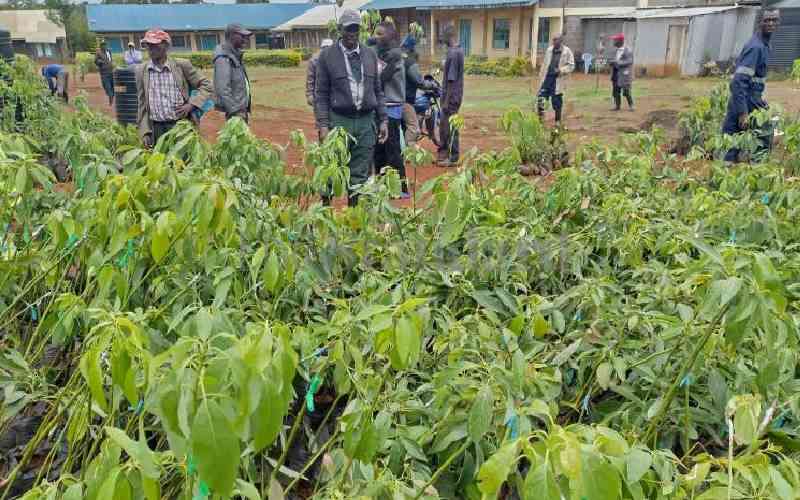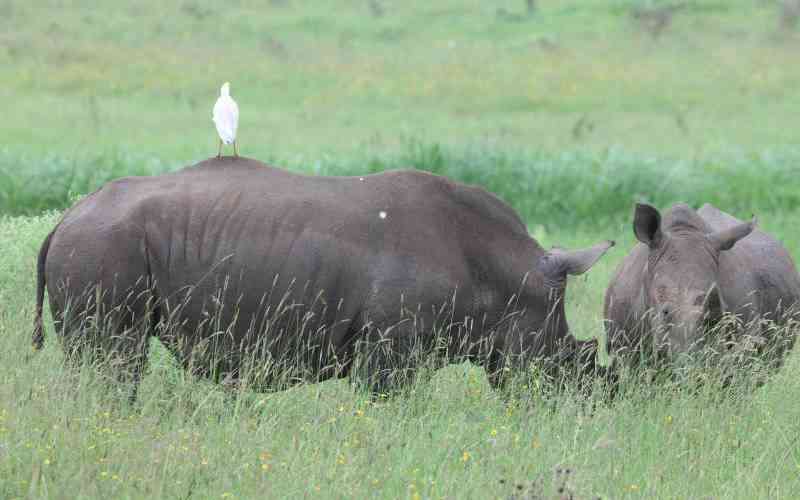South African veterinary doctor flew to Kenya for a mission last February – to conduct an eye surgery on two rhinos, which were believed to have contracted cataracts.
But unfortunately, the planned operation, which was to take place at the Ol’Jogi ranch’s animal theatre in Laikipia County, did not take place after veterinary doctors declared that the wild game’s eyes were damaged beyond repair.
The veterinary doctors from the ranch, Kenya Wildlife Service (KWS) and South African-based Vets United Against Poaching, examined the two black rhinos aged between six months and three years.
Isaac Lekolool from KWS said the eyes of the six-year old rhino, at the Ol’Jogi Ranch, were damaged in the rear part, and it was not possible for it to regain sight even after the operation.
“The blindness was caused by trauma, which includes injuries inflicted on it by other animals when fighting or it was pricked by tree branches when feeding,” said Lekolool.
Dr Lekolool said the surgery could not have rectified the problem, hence the unanimous decision to abandon it and place the animals under lose monitoring.
“Their security now depends on human beings. They now need close monitoring to secure them from poachers,” he added.
Lekolool and South African veterinary doctor, Anthony Goodhead led the operation.
The surgery was supposed to take place at a state-of-the-art animal theatre within the ranch.
If it succeeded as scheduled, it would have entered history books as the first successful surgical operation on a rhino in the history of Kenya, after another exercise scheduled at David Sheldrick Wildlife Trust in Nairobi was called off some few months ago.
“A preliminary examination on the rhino that was to be operated on indicated it was also extensively damaged,” said Goodhead, who has conducted 38 successful eye operations on rhinos in South Africa.
“It is unfortunate that both rhinos had effects on the rear of the eyes, and we could not henceforth carry out the operations,” said Goodhead.
The six-month old rhino, named ‘Nicky’ was from the world renowned Lewa Wildlife Conservancy in Isiolo.
“Nicky’s eye condition is congenital, meaning they started as it was developing in the womb,” said Goodhead.
Goodhead says blindness among rhinos posed a great risk to them, since they are vulnerable to poaching attacks.
Stay informed. Subscribe to our newsletter
“We also face the same problem of blindness among rhinos in South Africa, and so far, we have operated on 38 and they regained their sight,” said Goodhead. The veterinarian noted that there was urgent need for African countries to come up with modern security systems that will keep off poachers, as he linked increased cases to eye and other physical disabilities.
“Poaching is a big problem in Africa. In South Africa, we lost 102 rhinos to poachers in the first two months of this year. Last year, we lost over 600 rhinos, and all this is due to the rising demand for the tusks in the East.
Potentially blind rhinos are exposed at a greater risk of attacks by poachers,” he said, noting that South Africa has a population of about 20,000 rhinos.
In Mountain region Conservation area, KWS Assistant Director Aggrey Maumo said three rhinos-all blacks-have been killed by poachers in the region since January.
The recent attack was on a mother-rhino, which had given birth some six weeks before the killing.
He said early this year, poachers shot dead a rhino at Solio ranch and escaped with its horn.
“And on January 31, poachers raided Ol’Jogi ranch and shot and badly injured another rhino. They were, however, repulsed and could not chop its horn, but the rhino died the following day while undergoing treatment at the ranch,” said Maumo.
And another rhino was discovered dead within Aberdare National Park, Maumo added.
Dr Goodhead said: “Potentially, blind rhinos are exposed to more risk than the able ones, since they are not able to see poachers, and are not also able to run to their safety in case of an attack,” said Goodhead.
But despite the risk exposed to blind rhinos, stakeholders also noted that it is also challenging to examine all beasts in the wild so as to determine whether they are blind.
“These beasts are entirely in the wild and capturing them and examine their sight is a challenging and expensive task,” he said.
But still another issue raging is the presence of a meagre number of veterinary surgeons in Africa. In the planned surgeries, the ranches were forced to ‘import’ Goodhead from South Africa to come and conduct the surgeries. Goodhead was to be assisted by KWS doctor, Lekolool and Ol’Jogi’s veterinary doctor, Dr Steven Ngulu.
“Africa does not have enough veterinary doctors, and mostly, those specialising on eyes,” said Goodhead, who added that the sight problem is also prone in his country.
Lekolool observed that the sight problems are mostly caused by injuries when the animals are feeding.
“These animals operate in the wild and most of them suffer eye injuries while feeding,” said Lekolool.
He urged private ranchers, community and other conservation organisations to join in the fight to help salvage the few remaining rhinos.
 The Standard Group Plc is a
multi-media organization with investments in media platforms spanning newspaper
print operations, television, radio broadcasting, digital and online services. The
Standard Group is recognized as a leading multi-media house in Kenya with a key
influence in matters of national and international interest.
The Standard Group Plc is a
multi-media organization with investments in media platforms spanning newspaper
print operations, television, radio broadcasting, digital and online services. The
Standard Group is recognized as a leading multi-media house in Kenya with a key
influence in matters of national and international interest.
 The Standard Group Plc is a
multi-media organization with investments in media platforms spanning newspaper
print operations, television, radio broadcasting, digital and online services. The
Standard Group is recognized as a leading multi-media house in Kenya with a key
influence in matters of national and international interest.
The Standard Group Plc is a
multi-media organization with investments in media platforms spanning newspaper
print operations, television, radio broadcasting, digital and online services. The
Standard Group is recognized as a leading multi-media house in Kenya with a key
influence in matters of national and international interest.









